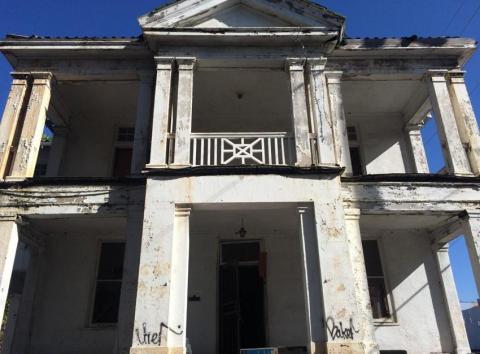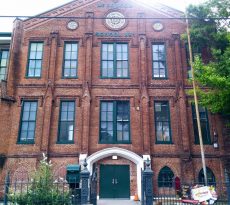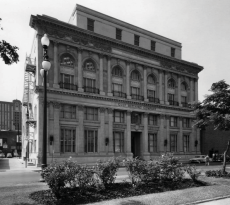The Louisiana Landmarks Society on Thursday (May 28) released the 2015 New Orleans Nine, which is their annual list of the nine most endangered historic sites in New Orleans.
The group’s goal is to make the public aware of the historic places so they can be saved, along with publicity for historic sites, advocacy for historic preservation, preservation education, and supporting proactive preservation efforts.
We’ve included the sites below, or you can check out this nifty interactive map that the Louisiana Landmarks Society put together on their website.
New Orleans Nine Most Endangered Sites 2015

Photo via louisianalandmarks.org
1. Former New Orleans and Carrollton Railroad Powerhouse
Location: 403 Napoleon
Threat: Demolition by Neglect
A masterpiece of late 19th century American industrial architecture, the masonry power station located at the corner of Tchoupitoulas Street and Napoleon Avenue designed by New Orleans based architect Thomas Sully was built in 1892 for the New Orleans and Carrollton Railroad Company. It was originally constructed to house turbines that converted water drawn from the nearby Mississippi River and artesian wells for the production of steam used by the railroad. While no longer used for its original function – it is reportedly still used by the Regional Transit Authority – this building is characteristic of Gilded Age commercial design that should be preserved. Potentially dangerous conditions urgently needing structural and masonry repairs are being ignored.

Photo via louisianalandmarks.org
2. Fort Pike
Location: 27100 Chef Menteur Highway
Threat: Deterioration, lack of repair
Fort Pike, located at Pass Rigolets, was the first fort designed and constructed as part of the United States’ Third System of coastal fortifications and was considered the most strategically significant fort for the protection of the country. Fort Pike was completed in 1826 and saw action during the Seminole Wars, the Mexican War and the Civil War before being decommissioned in 1890. The fort’s waterside location made it ideal to protect New Orleans, but is now contributing to its endangerment. In addition to acute damage from recent hurricanes, less obvious problems such as wave action, rising damp and uneven soil settling are threatening the stability of the fort.

Photo via louisianalandmarks.org
3. 924 Euterpe
Threat: Demolition by neglect
This is a fine example of a c. 1860-66 Greek revival double-galleried house, exemplary for its Lower Garden District location. Between 1866 and 1891, its owner and likely builder was Jeremiah Lincoln, a Maine native and proprietor of a local house raising company. When featured in the Friends of the Cabildo’s The Lower Garden District(1971), the building was still in relatively good condition, with its cast iron fence intact. Since 1980, however, the property has suffered from owner neglect. Numerous permits have been issued and fines levied by the Historic District Landmarks Commission, but no substantial improvements have occurred. Today extreme deterioration continues. Especially of concern is the gallery cornice which appears on the brink of collapse, endangering the adjacent picturesque cottage at 916 Euterpe.

Photo via louisianalandmarks.org
4. 518 Eleonore
Threat: Owner requested demolition and neglect
Largely obscured by overgrown trees and shrubbery, this c. 1860 galleried Creole cottage is the object of an unnecessary demolition request by its owner, a Nashville Avenue resident who purchased the house in November and plans to build a larger building on the lot. The home, a rare survivor of the antebellum period in old Hurstville, is in wholly repairable condition. A Creole cottage with classic floor plan and attached wings, it was built sometime after the 1858 purchase of the entire square by Francis Thomas, a butcher in the old uptown market between State and Eleonore Sts. The family resided in the cottage until 1890. The loss of this scarce link to the early days of Uptown would be irreparable.

Photo via louisianalandmarks.org
5. Carrollton Courthouse
Location: 701 S. Carrollton Avenue
Threat: Deterioration, potential demolition and inappropriate development
The Carrollton Courthouse was designed by the renowned architect Henry Howard. It once served as the Jefferson Parish seat of government and later housed various public schools. Today, the courthouse is the iconic architectural symbol of Carrollton. When the School Board sought in 1950 to raze the courthouse, a coalition of Carrollton residents and the newly-formed Louisiana Landmarks Society succeeded in saving it. Vacant since 2013, the courthouse could be auctioned to the highest bidder according to School Board plans. Because the courthouse is not a legally protected historic building, there is the possibility that it could even be demolished.

Photo via louisianalandmarks.org
6. Marsoudet-Caruso House
Location: 1519 Esplanade
Threat: Deterioration
In its 1977 New Orleans Architectural Series, the Friends of the Cabildo noted that this formerly elegant 1846 center-hall American cottage stood alone among commercial uses and vacant lots. The house was constructed for Mrs. Eliza Ducros Marsoudet by builders Nicholas Duru and Jacques Michel St. Martin. Still impacted by its environment and the nearby elevated interstate, the house has struggled to survive. In 2010 the future of the house was given new hope when Saint Anna’s Episcopal Church purchased the property in a lease-purchase agreement with the goal of turning it into a community center–Dodwell House–to expand their existing outreach programs. However, now the church is greatly challenged to raise funds to stabilize the building.

Photo via louisianalandmarks.org
7. S. W. Green Mansion
Location: 2501 Banks St.
Threat: Demolition by neglect
Son of a former slave, Smith Wendall Green made his fortune as a grocer and then as president of Liberty Independent Insurance. A delegate to Republican National Conventions and international officer of the Colored Knights of Pythias, Green was largely responsible for the 1909 construction of the Pythian Temple, an African American landmark, currently under renovation in the CBD. Weiss, Dreyfous & Seiferth, architects for Charity Hospital and the State Capitol, designed Green’s 1928 Craftsman-style, 17-room mansion on S. Miro. Partially burned by the KKK during construction, it nevertheless became a symbol of African American achievement. “Discovered” in the footprint of the proposed VA hospital by preservationists, the privately-owned mansion was moved with help from VA and the City across Rocheblave from the new medical complex, where it sits in disrepair.

Photo via louisianalandmarks.org
8. New Orleans Riverfront
Location: St. Thomas/Lower Garden District, Marigny, Bywater, Holy Cross, Algiers Point
Threat: Out of scale and incompatible development
Written public comments to the City Planning Commission suggest that 98% of the public wants to keep longstanding height limits for the city’s historic neighborhoods. Nevertheless, the recently approved Comprehensive Zoning Ordinance (CZO), the final step in the city’s years-long Master Planning process, calls for additional height allowances either by changing the zoning map or applying an “overlay district” along the Mississippi River, allowing structures to qualify for a “height bonus” of 25 feet. A 50% increase in heights to 75 and 80 feet along the river would be permitted if developers use certain design elements. Neighborhoods fear a loss of historic “sense of place” and scale if mid-rise towers are introduced in century-old neighborhoods.

Photo via louisianalandmarks.org
9. Touro Shakspeare Home
Location: 2621 General Meyer Ave.
Threat: Demolition by neglect
The Touro Shakspeare Home in Algiers was constructed in 1933 as a municipal almshouse. Designed by local architect William R. Burk, the building combines elements of both Neo-Classical Revival and Jacobethan Revival styles, and is particularly notable for its diamond-patterned polychrome brickwork, symmetrical massing, stepped parapets, and prominent front portico. The institution, named for philanthropist Judah Touro and former mayor Joseph Shakspeare, functioned as a city-owned nursing home until 2005. Vacant since Hurricane Katrina, the building has deteriorated significantly in recent years. Despite the continued neglect, it appears that the distinctive structure still retains many original exterior features and could be renovated either by the City of New Orleans (the current owner) or a private developer.





















In number 8 you imply that written public comments offer a representative sample of public opinion. That’s ridiculous. Otherwise it’s a great list.
[…] Check out the full list for 2017 below (and check out their list from 2015 too). […]